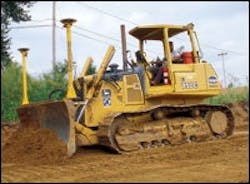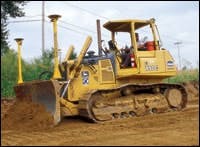GPS-Based Earthmoving's Awesome Technology
The original idea behind GPS, of course, was to enhance military defense capabilities, and by 1978, the U.S. Air Force was launching GPS satellites, completing the system in 1994. The technology's usefulness for civilian applications was soon recognized, however, and by the early 1990s, GPS was revolutionizing the surveying industry.
By the mid-1990s, large mining companies and quarries were embracing the technology to reduce costs. If blast holes in the quarry floor could be precisely located in an optimum pattern by using GPS, for instance, then blast yield and fracturing could be much improved. And in copper mines, loader operators with GPS could clearly identify ore bodies, and would no longer inadvertently send ore to the dump and worthless rock to the processor.
In the harsh conditions of mines and quarries, GPS suppliers learned, as they say, to "ruggedize" their products. And since the late 1990s, the lessons learned in these applications about durability and reliability have been transferred to earthmoving sites.
At its heart, GPS technology is based on constellations (groups) of satellites orbiting in space through predictable paths. The satellites serve as reference points for locating objects on Earth, and they do this by broadcasting coded radio signals. For our purposes, we can say that each satellite broadcasts two signals ("L1" and "L2"), which are identified as originating from a particular satellite by specific embedded information.
When we refer casually to "GPS," we usually mean the NAVSTAR-GPS constellation, the NAVigation System with Timing And Ranging—Global Positioning System. This system is funded and controlled by the U.S. Department of Defense and consists of 24 satellites and four orbiting spares.
A second satellite constellation is also available. The GLONASS (GLObal NAvigation Satellite System), established by the Russian government, presently has 11 satellites, and that number is expected to increase to 16 or 18 by 2005. Looking forward a few years, the European Community is contemplating its own constellation, GALILEO, and has recently commissioned test satellites.
(The three major North American suppliers of satellite-based earthmoving systems—Leica Geosystems, Topcon and Trimble—all build equipment that is compatible with the NAVSTAR constellation. Topcon also builds equipment that utilizes both the NAVSTAR and GLONASS constellations. Although we're using the term "GPS earthmoving" in this report, a more inclusive, more accurate term is "satellite-based earthmoving".)
The solar-powered satellites in the U.S. constellation orbit Earth every 11 hours and 58 minutes at an altitude of 12,500 miles. They are distributed in six orbital planes, an arrangement designed to keep at least four satellites in view 15 degrees above the horizon, anytime, anywhere. GLONASS satellites are in three orbital planes at an altitude of nearly 16,000 miles and orbit every 11 hours and 16 minutes.
Continually checking the NAVSTAR satellites are five radar-equipped "ground stations," located around the globe. The master station in Colorado Springs, Colo., processes the collected data, makes any required corrections in satellite position and signal timing, then sends out the information. Control of the GLONASS constellation operates in similar fashion, with four stations located across Russia.
The coded radio signals broadcast by the satellites are of no practical value, however, until they are picked up and processed by a GPS "receiver." The receiver's job, basically, is to report its position as the user moves through three-dimensional space. The receiver determines its position by measuring how far it is located from at least four, and preferably five, satellites all the time. In a perfect world, measuring to three satellites should do (a process called "trilateralization"), but most receivers require a minimum of five satellites for high-precision operation.
In the receiver's memory are reference copies of every satellite's signals, plus an "almanac," which allows the receiver to determine where in space given satellites are located at a given time. When a receiver is switched on, it first synchronizes its very accurate quartz clock with the satellites' atomic clocks, which control, on a very precise schedule, the start and finish of signal transmission.
What all this means, basically, is that when a receiver locks onto a particular satellite's coded signal, it can begin to run its reference code in sync with that coming from the satellite. Well, almost in sync. Because the satellite's signal is traveling a long distance to reach the receiver, it will be lagging slightly behind.
To synchronize the two signals, the receiver "slides" its code backward until it matches point-for-point with the one coming from the satellite. The distance (measured in time) that the receiver must adjust its code to get this match represents the satellite signal's travel time. The receiver then multiplies this time interval by the speed of light (the signal's theoretical travel speed) to calculate the distance, or range, to the satellite. It's a high-speed version of the old math problem: How far does a car travel in two hours at 60 mph?
Receivers vary widely in capability, from the $200 hand-held recreational model, to perhaps the $30,000 version in the cab of a motor grader equipped with machine-control. At the risk of oversimplification, technology differences in receivers center basically on the number of satellites they can track simultaneously, the sophistication of their processing software, the number of antennas from which they receive input, and whether they work with only the NAVSTAR constellation, or with both NAVSTAR and the GLONASS system. This latter consideration is also a matter of software capability.
The recreational receiver may have only one "channel" (satellite-signal receptor) and must process signals in a one-at-a-time sequence. In relative terms, this receiver's processing software is simple and slow. It uses only the L1 signal and its accuracy is around 30 feet in the horizontal and 60 feet in the vertical.
By contrast, a high-end receiver may have 40 channels, allowing it to simultaneously process both the L1 and L2 signals from 20 satellites, perhaps from both constellations. You'll hear terms applied to these receivers such as "dual frequency" (the ability to process both the L1 and L2 signals) and "carrier-phase processing" (the ability to analyze the satellite's signal frequencies).
All of this technology is aimed at helping the receiver get a closer match when synchronizing its code with that of the satellite. These technically advanced receivers also measure the distance to their satellites as often as 20 times per second, ensuring that their location reports are very current, or, have "low latency."
But, for all of its technology, the most sophisticated receiver still can't report its position with enough accuracy to be of any real value to an earthmoving contractor trying to set a close grade. That situation changes, though, when the technique of "differential GPS" is applied.
By way of explanation, we have been assuming all along, when describing how a GPS receiver measures distances to satellites, that satellite signals travel straight-as-an-arrow to Earth at exactly 186,000 miles per second (the speed of light). But this doesn't happen.
First, the speed of light is constant only in a vacuum. Plus, as the signals pass through various layers of atmosphere, electrical charges and moisture slow them down. Then, as the signals reach the Earth, they may bounce off buildings, trees and bridges, inducing "multi-path error."
A GPS system can greatly improve its accuracy, however, by minimizing the effect of these signal-distorting influences. It does so by employing "differential GPS," or DGPS. Several types of DGPS are available for various applications, such as "post-processed" for precise survey work and "code-correction" for navigation. The DGPS type that concerns the earthmoving contractor, however, is identified as "real-time kinematic" (RTK).
The RTK technique improves GPS accuracy by using two receivers working as a team on the jobsite. The first, the "base station," is stationary and, therefore, always knows its position on the work site. Because its position is fixed, the base-station receiver also knows its distance from each of the satellites it contacts.
So, when the receiver contacts a satellite, it can divide the known distance to that satellite by the speed of light to determine the precise time (theoretically) required for the satellite's signal to reach it. The receiver compares this theoretical travel time with the signal's actual travel time, then calculates the time delay (or time differential) that the signal is experiencing.
The base station is equipped with a radio and promptly sends out these time-delay corrections to the second receiver in the RTK system. This second receiver, the "rover," is moving about the site, whether in an earthmoving machine, an all-terrain vehicle, or in the grade checker's backpack. The rover receiver, which is measuring distances to satellites in the conventional manner, then uses the base station's information to correct its location reports for greater accuracy.
On earthmoving sites, the RTK technique typically yields accuracy in the horizontal dimension of ± 0.02 to 0.04 (two to four hundredths) of a foot, and about twice that in the vertical dimension. RTK, generally, is said to yield vertical accuracy of ± 0.10 (one tenth) of a foot. But in reality, depending on conditions, vertical accuracy can be considerably better.
Louis Avila, owner of L & K Equipment, and who, with partner/operator Bob Wilson, runs a GPS-equipped Cat 14G motor grader in Fresno, Calif., says that he's seen Wilson cut vertical grades to within 0.03 to 0.04 of a foot.
""When the surveyors came to stake curb and gutters," says Avila, "they were amazed at the closeness of the grade. It was consistently accurate to within five hundredths or less."




